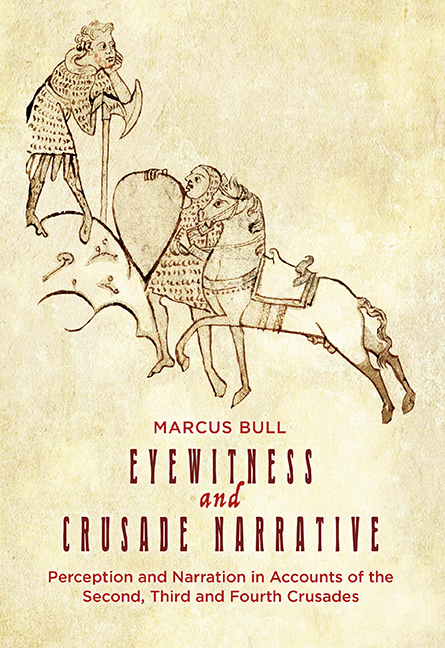 Eyewitness and Crusade Narrative
Eyewitness and Crusade Narrative Published online by Cambridge University Press: 12 February 2019
There is a category of historical evidence that historians are wont to characterize, and indeed to essentialize, as ‘eyewitness’. This is not just a technical term of art. The idea of being an eyewitness to something is deeply embedded in a wide range of cultural situations. We do not need to have a formal grounding in common law, for instance, to appreciate that the reliability of a witness who claims to have seen an event is normally greater than that of someone who is merely passing on hearsay. As is discussed in more detail below, sight and light are the basis of countless metaphors for understanding, realization and many other cognitive operations. So when we say that a historical source is ‘eyewitness’, we are making very large claims about it, even though the underlying assumptions about what we are saying have been surprisingly little studied relative to the importance of this category to the ways in which historians evaluate and deploy their evidence. All historical evidence that is the result or residue of human agency – as opposed to, say, tree-ring data and some types of archaeological deposit – has some experiential basis. But the particular appeal of eyewitness evidence is that, all other things being equal, it seems to close the gap between record and experience more than any other trace of the human past. It is through eyewitness evidence that we seem to get closest to validating the powerful instinct that people in the past must have led lives grounded in moment-by-moment sensory experience that was every bit as real to them as our lived experience is to us. In this way the category of eyewitness evidence seems to plug historical inquiry into basic human capacities that transcend cultural differences across time and space – or at least do so enough to grant us a meaningful point of entry into societies which in many respects can strike us as very dissimilar from our own. Eyewitnessing appears to be a powerful common denominator that permits us to understand and empathize with people in the past.
To save this book to your Kindle, first ensure [email protected] is added to your Approved Personal Document E-mail List under your Personal Document Settings on the Manage Your Content and Devices page of your Amazon account. Then enter the ‘name’ part of your Kindle email address below. Find out more about saving to your Kindle.
Note you can select to save to either the @free.kindle.com or @kindle.com variations. ‘@free.kindle.com’ emails are free but can only be saved to your device when it is connected to wi-fi. ‘@kindle.com’ emails can be delivered even when you are not connected to wi-fi, but note that service fees apply.
Find out more about the Kindle Personal Document Service.
To save content items to your account, please confirm that you agree to abide by our usage policies. If this is the first time you use this feature, you will be asked to authorise Cambridge Core to connect with your account. Find out more about saving content to Dropbox.
To save content items to your account, please confirm that you agree to abide by our usage policies. If this is the first time you use this feature, you will be asked to authorise Cambridge Core to connect with your account. Find out more about saving content to Google Drive.